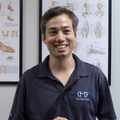
We know that most lower back disc herniations occur between the age range of 30 to 55 years old. In addition, those 45-55 years of age are particularly vulnerable. In order to understand why this occurs, let’s talk about:
- What a disc herniation is
- How a disc takes in nutrients and removes waste
- How age and injury can affect this process
What is a lumbar disc herniation?
First, know that our discs are like “spacers” and “shock-absorbers” which help distribute the loads that our lower back takes on, throughout our lifetime. We have 5 lumbar vertebrae and stacked in-between them, are our lumbar discs. Our lumbar discs are designed to handle high compressive loads, as well as to be malleable in order to allow for all the different motions and positions into which we put our lumbar spines.
If you were to take a bird’s eye view of a lumbar disc, it would have concentric annular rings, which look similar to the rings seen on top of a tree stump. In the middle is the nucleus, a viscous jelly-like material held in place by these annular rings. A disc herniation occurs when these rings fail over time and allow the nuclear material to be pushed out to the periphery.
Only the outer edges of the discs are highly innervated while the more internal, central portions are not. This means that you may not feel pain while this process is occurring over time until the “jelly”/nucleus starts to herniate out of the outermost annular rings during a disc herniation.
How do the Lumbar Discs Take In Nutrients and Remove Waste?
The lumbar discs have no direct blood supply, and therefore, nutrient and waste removal is dependent on a natural hydraulic system. This natural hydraulic system is working at its best when each motion segment (the vertebra connected above and below the disc) of the lower back is moving and stabilizing optimally. The function of this system is directly connected to the health of the discs, the health of the vertebral joints surrounding the discs, and the health of all of the soft-tissue connecting supporting and moving this system. Age, injury, and dysfunction change the way this system functions and its ability to remove waste and deliver nutrients to the disc.
Note: Manual and Movement Medicine can help identify dysfunctional movement segments and improve the way they move and function.
Age, and Disc Herniations:
Disc herniations are rare in those under 20 years of age. The discs remain optimally hydrated when we’re in our youth and up until our late 20’s. Our motion segments tend to work optimally during this time, unless exposed to injury or excessive forces.
By our early 30s, advanced imaging like MRIs, begin to show signs of dehydration and breakdown in our lower back discs. The connection between the discs and the vertebra, where much of the nutrient exchange happens, begins to thicken and harden (making nutrient exchange more difficult) during this time. This is part of the natural aging process, but injury and excessive forces on our discs can speed up this process and push the continuum toward disc herniations.
As the disc dehydrates it becomes more brittle and less resistant to forces. During our 40s and 50s our discs are at an “in-between”. They are becoming dehydrated and breaking down, but are still hydrated enough and large enough to allow the nuclear material to push against the surrounding annular rings, causing disc herniations.
In contrast, by the time our discs dehydrate and degenerate more thoroughly in our late 60s onward, they shrink in height and size and are unlikely to herniate if they haven’t already. Lower back conditions later in life, come from the loss of disc height and the degenerative changes that follow.
The type of Manual Treatment we provide at CMF has shown clinically positive and significant results in our patients living with disc herniations. If you’re suffering from a disc herniation, we’re here to help! Contact us today (561) 318-8070 to get on the road to recovery.






